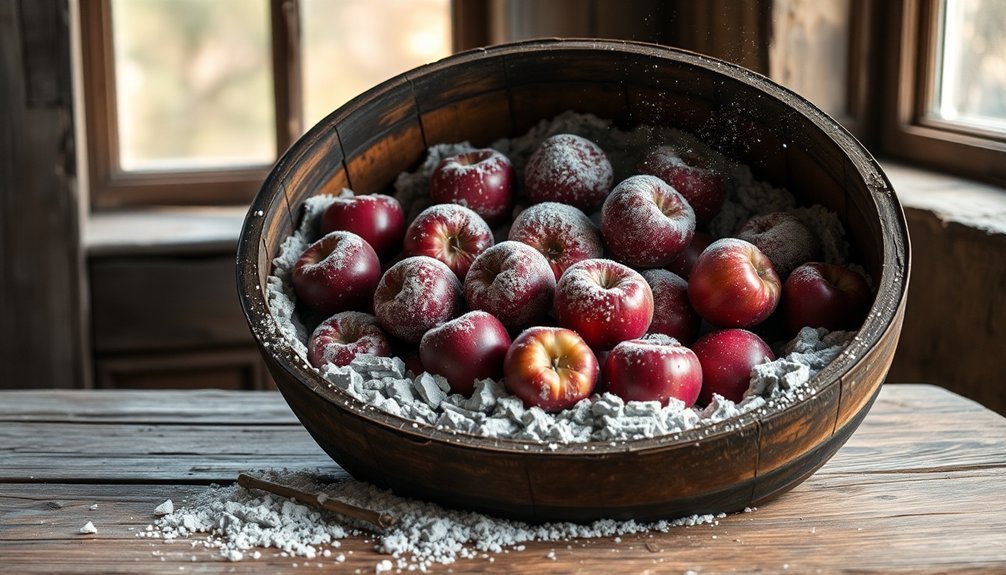You'll find three standout methods for preserving food with wood ash, each proven effective over centuries of use. Hard cheese storage involves coating the cheese in ash to prevent moisture damage while developing a flavorful rind. For tomatoes, you'll want to layer them with cool, dry ash in a wooden container, extending their life up to 6 months. Meat preservation requires covering cuts with 15cm of sieved ash and curing for 1-1.5 weeks per centimeter thickness, resulting in a uniquely nutty flavor. These time-tested techniques offer just the beginning of wood ash's remarkable preservation capabilities.
Hard Cheese Preservation

The wood ash serves multiple purposes: it keeps pests away, prevents moisture damage, and blocks air exposure that could lead to spoilage.
Storing cheese in a breathable environment helps maintain its quality over time. As your cheese ages in the ash, you'll notice it develops a new rind and may take on a saltier, grainier texture similar to aged parmesan.
While you should check periodically for any signs of degradation, you can expect your properly stored cheese to remain fresh for an extended period.
Tomato Storage Methods
Successfully preserving tomatoes in wood ash requires careful selection and preparation of both the produce and storage materials. Choose tomatoes that are just beginning to ripen, showing their first blush of red, and guarantee they're free from bruises or blemishes. Long Keeper varieties work particularly well for this preservation method.
You'll need to prepare your wood ash carefully by sifting it multiple times to remove debris and sharp particles. Line your wooden box or woven basket with paper, then create alternating layers of ash and tomatoes, placing them stem-side down. Start with a 1.5-inch ash base and finish with a protective ash layer on top. Research from farmer Vital Nduwimana demonstrated that this technique can keep tomatoes fresh for 5-6 months in Burundi.
Key factors for successful tomato preservation in wood ash:
- Select tomatoes at early ripeness stage – they should be firm but showing color change
- Use only cool, dry wood ash from known tree species
- Maintain consistent storage temperature in a cool, dry location
- Position tomatoes stem-down in single layers
- Monitor regularly for ideal preservation conditions
When done correctly, this method can preserve your tomatoes for three to six months, though you may notice some changes in visual quality while the inner pulp remains fresh.
Meat and Egg Preservation

Preserving meat and eggs in wood ash stands out as one of the most reliable traditional preservation methods.
For meat preservation, you'll need a cardboard box or airtight container, sieved wood ash, and pieces of wood for elevation. Cover your prepared meat with at least 15cm of ash on all sides, and maintain temperatures between 15-25°C. You'll need to cure the meat for 1-1.5 weeks per centimeter of thickness, resulting in tender meat with a nutty flavor similar to Parma ham. This method has been a northern German tradition for generations.
For eggs, you'll want to use natural wood ash and unwashed eggs to maintain their protective coating. You can enhance preservation by coating eggs with cooled, melted lard before packing them small end down in your container. Cover them completely with sifted ash and store in a cool environment like a basement or root cellar.
Don't disturb the ash layer unnecessarily during storage.
Both preservation methods rely on wood ash's ability to control moisture and prevent bacterial growth. Your meat will develop a distinctive taste, while eggs can stay fresh for up to a year when properly stored.
Remember to check periodically but minimize air exposure to maintain the protective environment.
Frequently Asked Questions
Which Types of Wood Create the Safest Ash for Food Preservation?
You'll want to use hardwoods like maple, oak, and hickory for the safest ash. They're rich in nutrients and produce cleaner ash. Don't use softwoods or treated lumber, as they can contain harmful contaminants.
Can Wood Ash Preservation Affect the Nutritional Value of Foods?
You'll find that wood ash preservation won't greatly impact your food's nutritional value. It creates a sterile barrier without altering macronutrients, and when stored properly, vitamins and minerals stay largely intact.
How Do You Properly Clean Preserved Foods Before Consumption?
You'll need to gently brush off excess ash with a soft cloth or brush. Don't use water unless necessary. Inspect the food carefully for spoilage, and remove any ash-affected outer layers before you consume it.
What Are Signs That Ash-Preserved Food Has Gone Bad?
You'll know your ash-preserved food has spoiled if you notice mold, unusual colors, slimy textures, off-putting smells, or foamy bubbles. Look out for ammonia odors and any signs of container rust.
Should Wood Ash Be Mixed With Other Preservatives for Better Results?
You shouldn't mix wood ash with other preservatives. It's effective on its own, and mixing could cause harmful chemical reactions or reduce its natural benefits. Stick to using wood ash alone for best results.
In Summary
You've now learned three effective ways to use wood ash for preserving different types of food. Whether you're storing hard cheese in ash-lined containers, keeping tomatoes fresh with ash coating, or using ash preservation methods for meat and eggs, you'll extend your food's shelf life naturally. Try these time-tested techniques, and you'll see why wood ash has been a valuable preservation tool for generations.





Leave a Reply